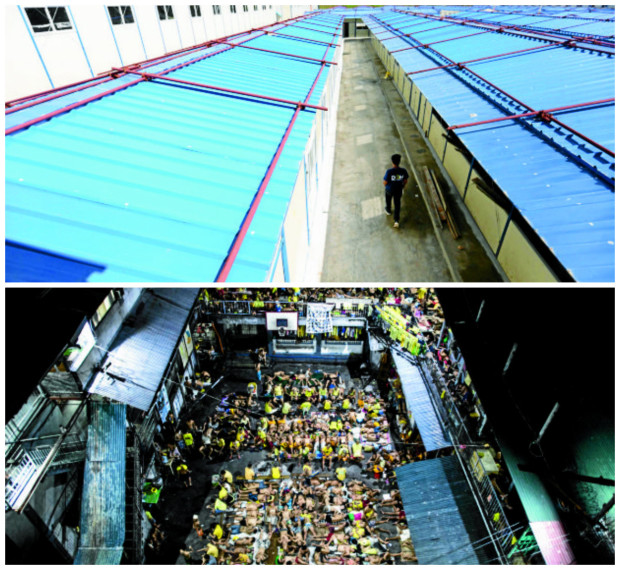Jails full of drug addicts, Ecija rehab center has few

CONTRASTING SCENES While the Drug Abuse Treatment and Rehabilitation Center in Nueva Ecija (top photo), which was opened four months ago and can accommodate 3,000 drug dependents, is nearly empty, jails in Quezon City (bottom photo) and other cities are heavily congested. JOAN BONDOC/AFP
The country’s largest drug rehabilitation center, envisioned to house up to 10,000 addicts, is treating only a few patients even as many city jails are bursting at the seams with the influx of at least 25,000 users amid the administration’s war on drugs.
Four months after it opened, the Drug Abuse Treatment and Rehabilitation Center (DATRC) at Fort Magsaysay in Nueva Ecija is treating only a handful of addicts, an official of the Department of the Interior and Local Government (DILG) said on Thursday.
“Nobody’s volunteering to treat themselves. Nobody’s going there anymore,” said Ricojudge Janvier M. Echiverri, assistant interior secretary for external and legislative affairs.
Echiverri said the drug rehabilitation center was so big but hardly anyone was using it. “It’s not being used and we’re spending so much for the maintenance.”
He spoke at the launching of a project by the Bureau of Jail Management and Penology (BJMP) and International Committee of the Red Cross to decongest the country’s jails.
Article continues after this advertisementCongestion rate
Article continues after this advertisementChief Supt. Allan Iral, BJMP deputy chief for operations, said the congestion rate in some of city jails had risen to 3,000 percent due to the influx of inmates charged with drug cases.
The average congestion rate for BJMP jails across the country is 555 percent, he said.
“In urbanized areas, more than 80 percent (of the jail) population are there due to drugs,” Iral said.
He said the BJMP jail population stood at 110,000 last year but this ballooned to “close to” 140,000 after the war on drugs was launched.
He said the BJMP’s 466 jails across the country was intended to house only 20,000 to 25,000 inmates, adding that the bureau had around 13,000 personnel.
“This is the second notable increase in our jail population. The first one was in 2002, when the Comprehensive Dangerous Drugs Act was passed,” Iral said.
Still under construction
The 10-hectare rehabilitation center in Nueva Ecija has a current capacity of “2,000 to 3,000” patients because its remaining buildings are still being constructed, Echiverri said.
“We are dismayed because the government is spending so much and yet nobody’s patronizing it,” he said.
A Chinese real estate magnate, Huang Rulun, donated the funds for the construction of the center but the Department of Justice (DOJ) is spending money to maintain it.
“There are a lot of DOJ personnel there so what will they do there? They have nothing to do while waiting (for more patients),” he said.
The center was supposed to accommodate a portion of the 1.2 million drug users who have turned themselves in under the Philippine National Police’s “Oplan Tokhang.”
“But you can’t force someone to go there because it’s voluntary. These are not prisoners,” Echiverri said.
Judges’ referrals
He said he would write a letter to the Supreme Court administrator, Justice Midas Marquez, to issue a directive requiring judges to refer drug users to the Nueva Ecija facility if there was no more room at the rehab centers in Parañaque and Tagaytay.
“The [drug users] want [Parañaque] or Tagaytay because it’s nearer and it’s cold but the facility (in Nueva Ecija) is already there. We might as well use it,” he said.
Echiverri said some might balk because the Nueva Ecija center was inside Fort Magsaysay, a military camp.
He said the camp was very nice. “If you will see, it’s nature-tripping there, but of course, they don’t go there for that.”
Besides the Nueva Ecija facility, President Duterte recently led the groundbreaking of a P700-million drug rehab center in Malaybalay, Bukidnon.
Once finished, it can house more than 5,000 drug patients.
Swelling number of inmates
Iral said the regions with the highest increase in the number of inmates were the Ilocos, Central Luzon, Central Visayas, the Zamboanga Peninsula and Davao.
He said that if international standards were to be followed, there should be only one inmate per 4.7 square meters.
“So, if it’s 1,000-percent congested, you add 10 inmates. Instead of just one inmate, you have 11 sharing that space,” he added.
Iral said that in some city jails, like Quezon City Jail, the congestion rate had reached 3,000 percent.
He said the country’s total jail population was more than 200,000, with the BJMP having nearly 140,000 inmates, provincial jails around 40,000, and the Bureau of Corrections about 50,000.